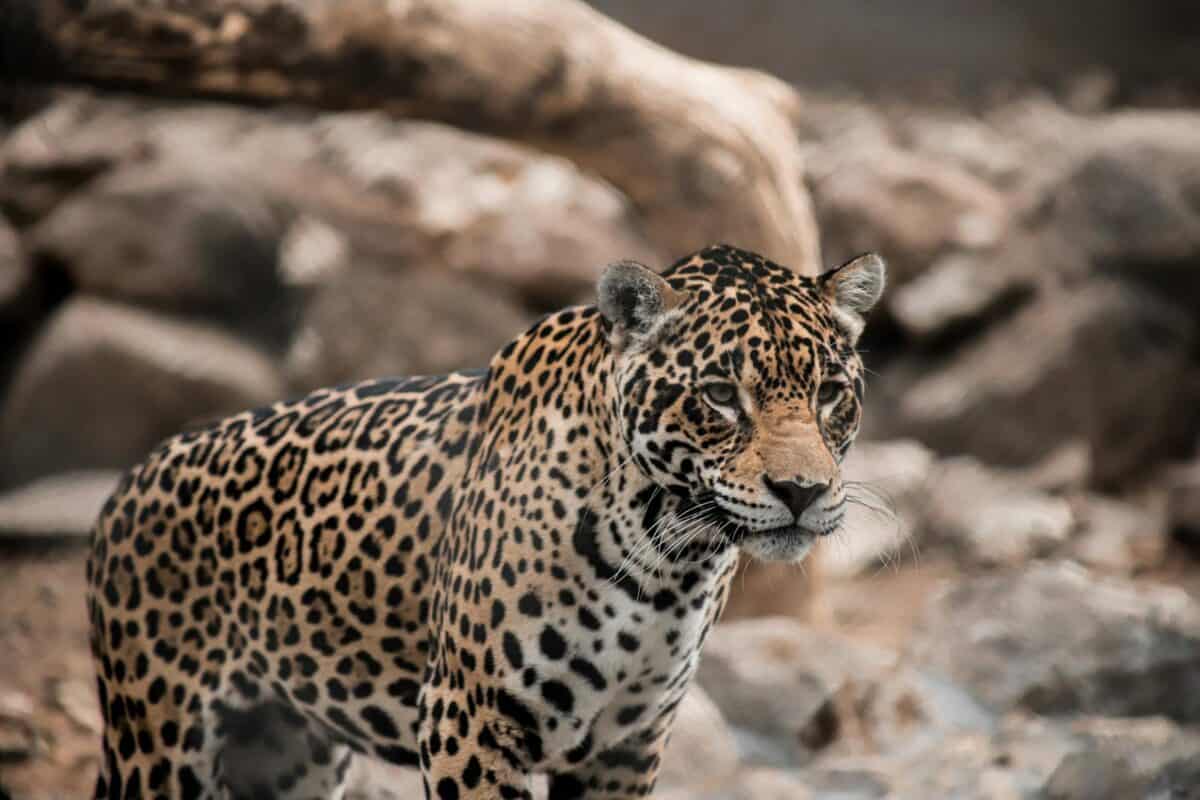The Amazon Rainforest stands as Earth’s most biodiverse ecosystem, a living laboratory spanning nine countries across South America. This verdant paradise houses an estimated 10% of all known species on our planet, with countless others still awaiting discovery. From microscopic insects to massive mammals, the Amazon’s inhabitants have evolved remarkable adaptations to thrive in this complex environment. For wildlife enthusiasts and adventurous travelers, the prospect of encountering the Amazon’s most extraordinary residents represents the ultimate nature experience. This article explores 11 of the most fascinating animals you might encounter during a journey through this magnificent rainforest, creatures that showcase the incredible diversity and evolutionary marvels that make the Amazon an irreplaceable treasure of our natural world.
11. Jaguar The Apex Predator

The jaguar (Panthera onca) reigns as the Amazon’s undisputed apex predator, commanding respect throughout the rainforest ecosystem. With a powerful build and distinctive rosette-patterned coat, these magnificent cats can weigh up to 300 pounds, making them the third-largest big cat species globally. What truly sets jaguars apart is their exceptional bite force—the strongest of any big cat—allowing them to pierce turtle shells and crocodilian armor with ease. Unlike many felines, jaguars are excellent swimmers who frequently hunt caiman and fish in rivers and streams.
Encountering a jaguar in the wild is an increasingly rare privilege as habitat fragmentation threatens their populations. These solitary hunters are most active at dawn and dusk, preferring densely vegetated areas near water sources. While notoriously elusive, certain protected areas like Brazil’s Pantanal region offer higher chances of spotting these magnificent cats. Conservation efforts focus on maintaining connected forest corridors that allow jaguars to maintain their crucial role as ecosystem regulators, keeping prey populations in check and maintaining the delicate balance of the Amazon’s food web.
10. Pink River Dolphin The Mythical Shapeshifter

The Amazon River dolphin (Inia geoffrensis), commonly known as the pink river dolphin or boto, represents one of the rainforest’s most distinctive and mysterious inhabitants. These freshwater cetaceans earn their nickname from the vibrant pink hue adult males develop—a coloration thought to result from scarring and blood vessel activity beneath their skin. Unlike their ocean-dwelling relatives, these dolphins possess a flexible neck allowing them to navigate the flooded forest floor during seasonal inundations. With bodies reaching up to 8 feet long and weighing around 400 pounds, they use their exceptional sonar abilities to hunt in the murky Amazon waters.
Beyond their biological significance, pink river dolphins occupy a prominent place in Amazonian folklore. Many indigenous communities believe these creatures are shape-shifters capable of transforming into handsome men who seduce village women before returning to the river. This mystical status has historically offered the species some protection, though modern threats from dam construction, mercury pollution from gold mining, and occasional hunting have placed them in a vulnerable conservation status. Ecotourism initiatives focused on dolphin watching now promote their protection while offering visitors unforgettable encounters with these intelligent, curious mammals who often approach boats with apparent interest in human observers.
9. Giant River Otter Social Swimmers
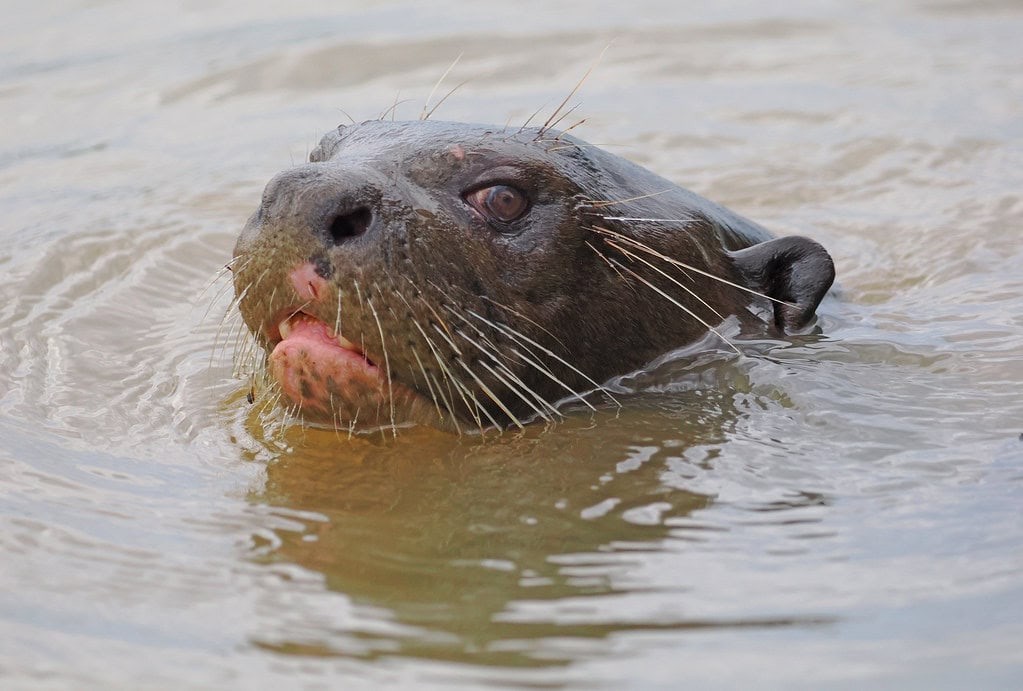
The giant river otter (Pteronura brasiliensis) represents the rainforest’s answer to social predation, with family groups dominating river territories throughout the Amazon Basin. Growing up to 6 feet long and weighing over 70 pounds, these massive mustelids dwarf their better-known North American relatives. Each otter possesses a unique throat pattern—similar to a human fingerprint—allowing researchers to identify individuals. Their streamlined bodies and powerful tails make them exceptional swimmers, capable of reaching speeds of 8 mph underwater while hunting fish, caimans, and even small anacondas.
Giant river otters live in highly social family groups typically consisting of a mated pair and their offspring from multiple seasons. These vocal animals communicate through an elaborate system of calls, with each family developing its own “dialect.” Their complex social behavior includes cooperative hunting, communal care of young, and coordinated defense against predators like jaguars and caimans. Once widespread throughout the Amazon, giant river otters now face critical endangerment from habitat loss, water pollution, and historical fur hunting. Conservation areas along protected waterways provide crucial havens for remaining populations, where lucky visitors might witness their playful behavior and remarkable family dynamics.
8. Poison Dart Frog Tiny but Deadly
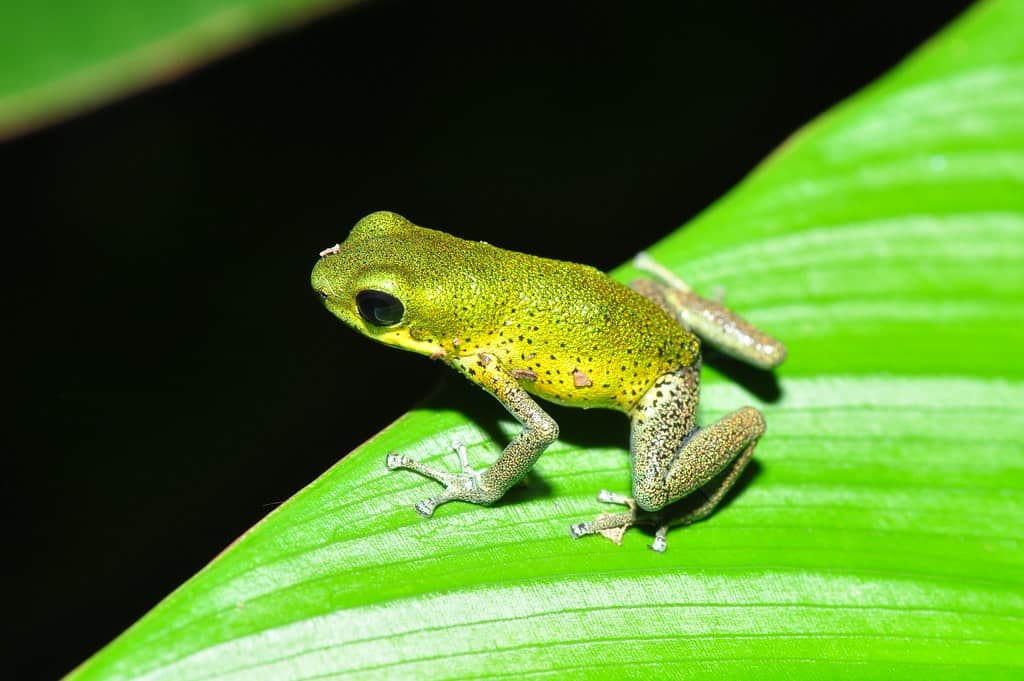
Poison dart frogs (family Dendrobatidae) represent nature’s warning system at its most vivid—these thumbnail-sized amphibians sport some of the most brilliantly colored skins in the animal kingdom, ranging from electric blue to fiery orange and vibrant yellow. Their eye-catching appearance serves as aposematic coloration, a natural warning to potential predators about the powerful toxins secreted through their skin. The most dangerous species, the golden poison dart frog, carries enough toxin to kill 10 adult humans, making it one of the deadliest animals on Earth relative to its size. Interestingly, these frogs don’t produce their toxins independently but acquire them through their diet of specific insects that contain alkaloid compounds.
Beyond their toxic defenses, poison dart frogs display fascinating reproductive behaviors. Males court females through elaborate calls and territorial displays, and after mating, either parent may carry the developing tadpoles on their backs to suitable water bodies. Some species even deposit unfertilized eggs as food for their developing tadpoles in small water pools formed in plant leaves. While their vivid colors make them relatively easy to spot for careful observers walking the rainforest floor, their populations face threats from habitat destruction and the exotic pet trade. For photographers and naturalists, safely observing these miniature marvels in their natural habitat offers a glimpse into the complex chemical warfare that shapes rainforest ecology.
7. Harpy Eagle The Flying Predator
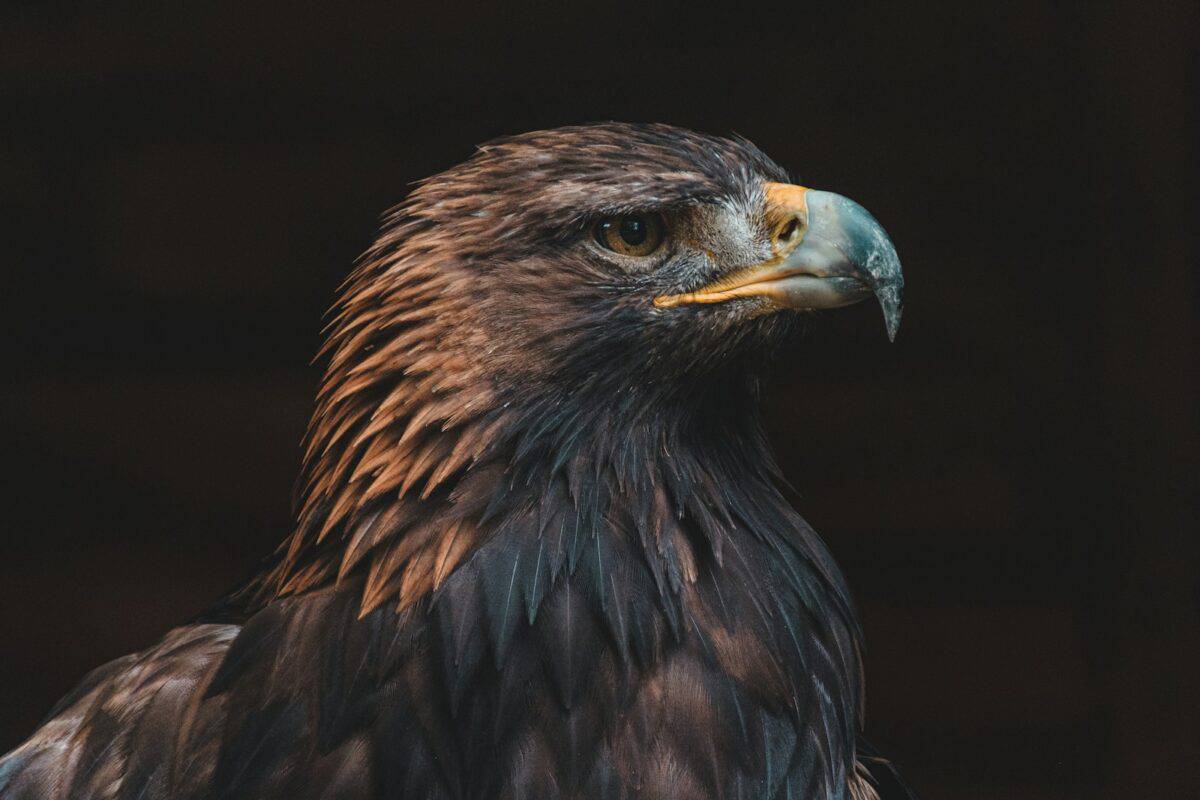
The harpy eagle (Harpia harpyja) represents the Amazon’s most formidable aerial predator, a massive raptor that inspires both awe and fear throughout the rainforest canopy. With females weighing up to 20 pounds and sporting a wingspan reaching 7 feet, these birds rank among the world’s largest and most powerful eagles. Their massive talons—comparable in size to grizzly bear claws—can exert pressures of 110 pounds per square inch, allowing them to snatch prey as large as monkeys and sloths from tree branches. A distinctive crown of feathers that can be raised when excited or threatened gives these birds their name, inspired by the fearsome harpies of Greek mythology.
Harpy eagles maintain extraordinarily large territories, with a single pair requiring up to 25 square miles of undisturbed forest to support their hunting needs. This requirement makes them particularly vulnerable to habitat fragmentation. They reproduce slowly, raising only one chick every 2-3 years, with young eagles dependent on their parents for up to 10 months after fledging. Conservation efforts focus on protecting large tracts of intact forest and working with local communities to prevent hunting. For birdwatchers, glimpsing a harpy eagle represents a rare privilege—their population density is naturally low, and spotting one typically requires guided expeditions to known nesting sites in protected reserves. Their presence serves as a crucial indicator of healthy, functioning forest ecosystems.
6. Green Anaconda The Massive Constrictor

The green anaconda (Eunectes murinus) holds the title of the world’s heaviest snake, with documented specimens reaching lengths over 25 feet and weights exceeding 500 pounds. These massive constrictors spend much of their lives in or near water, perfectly adapted to the Amazon’s complex river systems and seasonal flooding. Unlike venomous snakes, anacondas rely on their immense muscular power to subdue prey through constriction, gradually tightening their coils with each exhale of their victim until suffocation occurs. Their diet includes capybaras, caimans, deer, and occasionally jaguars, with larger females capable of consuming prey weighing over 100 pounds.
Despite their fearsome reputation—enhanced by Hollywood exaggeration—anacondas rarely pose threats to humans, preferring to avoid confrontation when possible. Females grow significantly larger than males, and during breeding season, “breeding balls” may form where multiple males compete to mate with a single female. After mating, females give birth to live young rather than laying eggs, with litters sometimes exceeding 40 babies, each already measuring nearly 2 feet long. While not endangered, anaconda populations face pressure from habitat degradation and occasional killing by humans who fear them. For responsible ecotourists, spotting these magnificent reptiles in their natural habitat, often with just their eyes and nostrils breaking the water’s surface, provides an unforgettable glimpse into the prehistoric power that still thrives in the Amazon’s waterways.
5. Capybara The Giant Rodent

The capybara (Hydrochoerus hydrochaeris) holds the distinction of being the world’s largest rodent, with adults typically weighing between 100-150 pounds and standing about two feet tall at the shoulder. These social, semi-aquatic mammals thrive throughout the Amazon Basin, particularly in wetland areas where they can readily access their preferred habitats: grasslands for grazing and water bodies for safety. Their barrel-shaped bodies, webbed feet, and eyes and nostrils positioned high on their heads all represent adaptations for their semi-aquatic lifestyle. Capybaras can remain submerged for up to five minutes when evading predators and often sleep partially submerged to maintain awareness of potential threats.
Social structure forms a crucial aspect of capybara life, with groups typically consisting of 10-20 individuals led by a dominant male. These groups function as cooperative units for predator detection, with members taking turns watching for danger while others feed. Perhaps most remarkably, capybaras have developed mutually beneficial relationships with many bird species, allowing birds to land on them to remove ticks and insects. Their gentle nature and unique appearance make them popular subjects for wildlife photography, and sustainable ecotourism now promotes their conservation. While not endangered overall, capybara populations in certain regions face pressure from habitat conversion to agricultural land and hunting for their meat and hide, highlighting the importance of protected areas that maintain the wetland ecosystems these charismatic rodents depend upon.
4. Scarlet Macaw The Colorful Aviator

The scarlet macaw (Ara macao) epitomizes the vibrant beauty of Amazonian wildlife, with its spectacular plumage combining brilliant red, yellow, and blue in a display visible from remarkable distances through the rainforest canopy. These large parrots measure up to 3 feet from beak to tail tip and can live 50+ years in the wild, forming lifelong monogamous pairs that communicate through a complex repertoire of calls. Their powerful beaks have evolved to crack open the hardest nuts and seeds in the rainforest, allowing them access to food sources unavailable to other birds. This same tool serves as an effective climbing aid, helping macaws navigate through the complex three-dimensional environment of the upper canopy.
Beyond their visual splendor, scarlet macaws play crucial ecological roles as seed dispersers, carrying large seeds across significant distances before discarding them in new locations where they can germinate. Their intelligence rivals that of many mammals, with problem-solving abilities and complex social behaviors making them fascinating subjects for both scientific study and wildlife observation. Unfortunately, their beauty has made them targets for the illegal pet trade, while habitat loss from deforestation presents another serious threat. Conservation initiatives now focus on protecting critical breeding sites and establishing wildlife corridors between fragmented habitats. For visitors to the Amazon, the sight of scarlet macaws in flight—often traveling in pairs or small groups at dawn and dusk—offers one of the rainforest’s most memorable and photogenic wildlife experiences.
3. Black Caiman The Ancient Predator
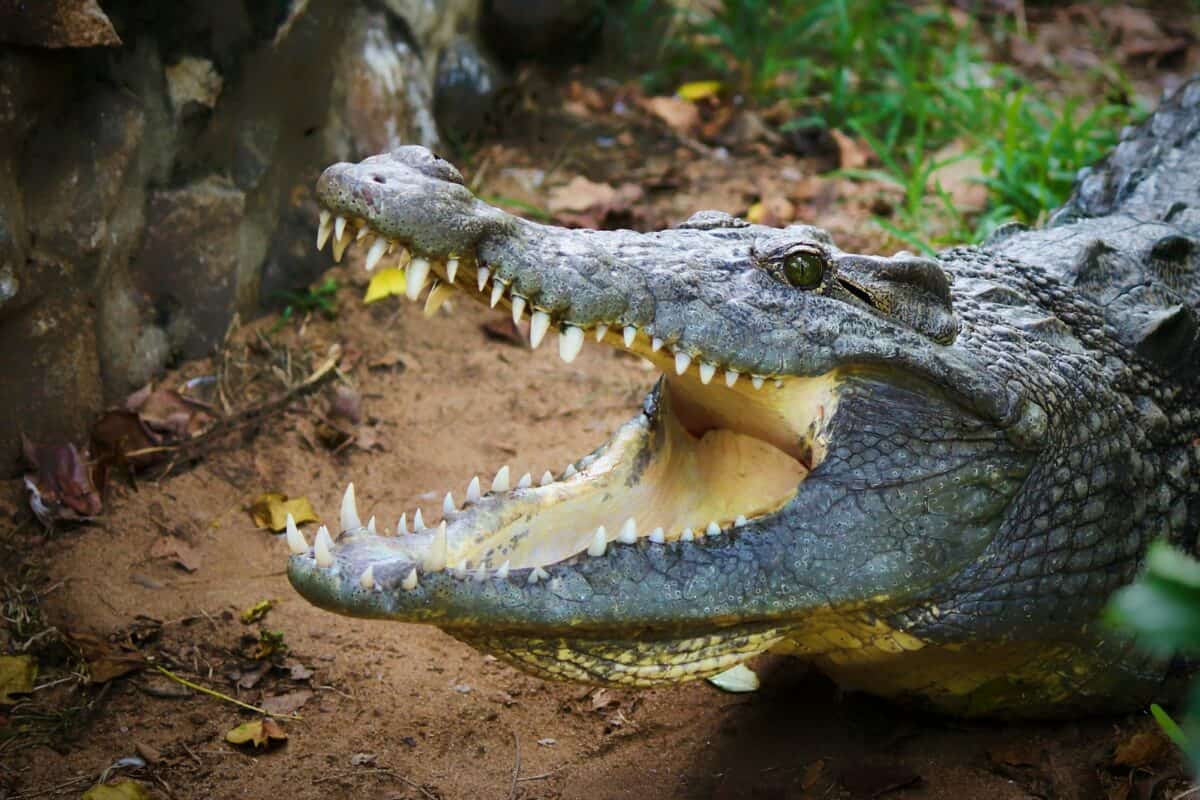
The black caiman (Melanosuchus niger) represents the Amazon’s largest predatory reptile and the biggest member of the alligator family, with exceptional specimens reaching lengths of 20 feet and weights over 1,000 pounds. These ancient creatures have remained virtually unchanged for millions of years, perfecting their role as ambush predators in the region’s rivers and lakes. Their dark coloration—nearly black on adults—provides excellent camouflage during nighttime hunting, when they’re most active. With crushing bite forces exceeding 2,500 pounds per square inch, black caimans can overpower virtually any prey that approaches the water’s edge, from capybaras and deer to occasional jaguars.
Female black caimans display remarkable maternal care, constructing large mound nests from vegetation where they lay 30-60 eggs, then guarding them vigilantly against predators throughout the 45-day incubation period. After hatching, mothers carry their offspring to water in their mouths and continue protecting them for up to two years. While once driven to near-extinction by hunting for their valuable skins, international protection has allowed some populations to recover, though habitat degradation and pollution continue to threaten their long-term survival. For visitors to the Amazon, nighttime boat excursions offer opportunities to spot these impressive reptiles, their eyes glowing red when illuminated by flashlights—a primeval reminder of the predatory forces that have shaped Amazonian ecosystems for millennia.
2. Hoatzin The Prehistoric Bird

The hoatzin (Opisthocomus hoazin) stands as one of the Amazon’s most unusual and evolutionarily distinct birds, often referred to as the “stinkbird” due to the manure-like odor produced by its unique digestive system. This chicken-sized bird sports a spiky crest, blue facial skin, and reddish-brown plumage, giving it a prehistoric appearance that matches its ancient lineage. Unlike most birds, hoatzins have foregone the typical avian digestive system in favor of bacterial fermentation in an enlarged crop—similar to how cows digest food—allowing them to consume otherwise toxic leaves that other birds cannot process. This specialized diet gives them their characteristic smell but also provides exclusive access to abundant food resources.
Perhaps most remarkably, hoatzin chicks are born with functional claws on their wings—a feature lost in most modern birds but present in their dinosaur ancestors including Archaeopteryx. These claws allow newly hatched birds to climb back to their nests if they fall or dive into water to escape predators. Hoatzins typically live in social groups along forest waterways, building flimsy nests in branches overhanging water. Their poor flying abilities and distinctive appearance make them relatively easy to spot during river excursions, offering wildlife enthusiasts a glimpse of what appears to be a living fossil. While not currently endangered, their specialized habitat requirements make them vulnerable to widespread forest clearance, particularly along riverbanks where they concentrate their nesting activities.
1. Three-Toed Sloth The Slow-Motion Specialist

The three-toed sloth (genus Bradypus) embodies nature’s alternative approach to survival—instead of speed or strength, these remarkable mammals have perfected the art of energy conservation. Moving at speeds rarely exceeding 0.15 miles per hour, they represent the slowest mammals on Earth, an adaptation that helps them remain inconspicuous to predators while subsisting on a low-calorie diet of leaves. Their specialized metabolisms operate at just 40-45% the rate expected for mammals of their size, allowing them to survive on minimal nutrition. Perhaps most incredibly, three-toed sloths descend from their canopy homes to the forest floor just once weekly to defecate, a risky journey that still puzzles scientists but may help fertilize their preferred trees.
Their fur hosts an entire ecosystem of symbiotic algae, fungi, and invertebrates—including moths that live exclusively in sloth fur. The greenish tinge imparted by algae provides excellent camouflage among the leaves where they spend most of their lives. Three-toed sloths typically live solitary lives except during brief mating encounters, with females raising single offspring that cling to their mother’s fur for 6-9 months before independence. While their slow lifestyle has protected them from many threats, deforestation poses serious challenges as sloths cannot traverse large open areas between forest fragments. For wildlife watchers, spotting their ball-like form high in the canopy requires patience and sharp eyes, but offers a glimpse of one of evolution’s most specialized mammals—creatures that have survived 60 million years by perfecting the art of doing less.
Conclusion: A Living Wonder Worth Protecting
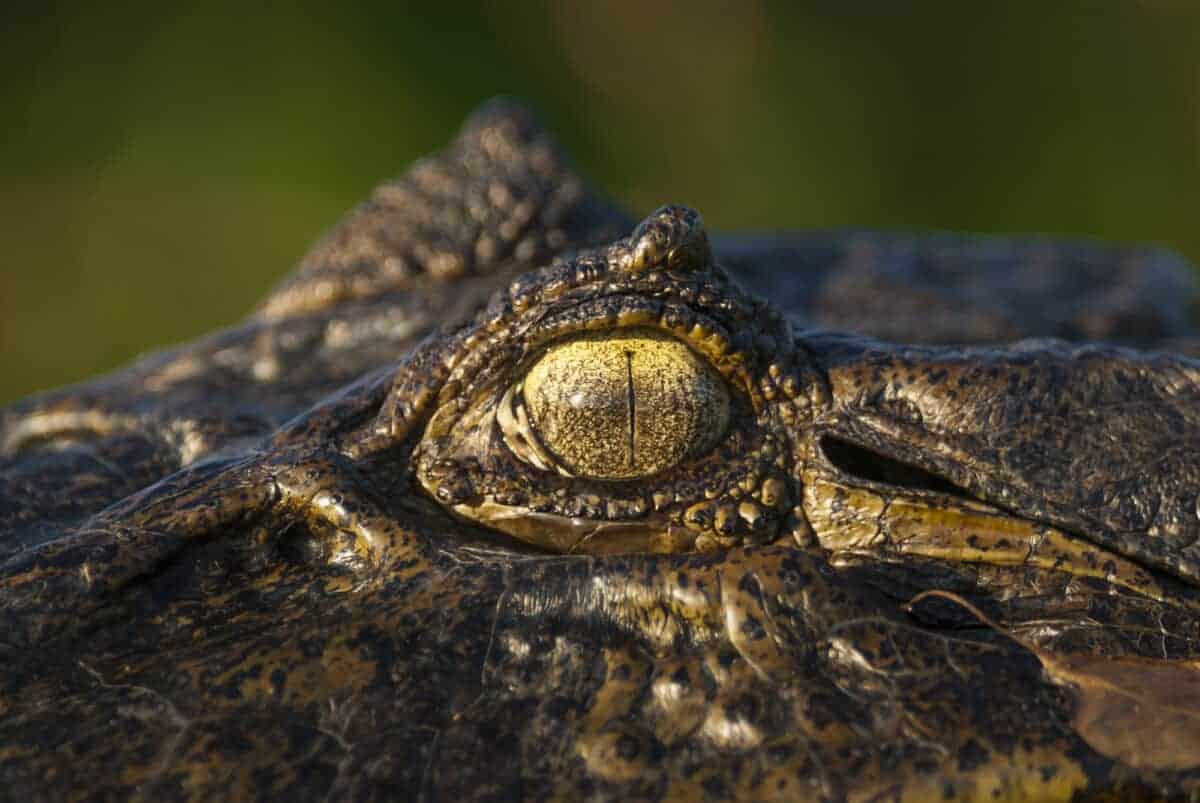
The Amazon Rainforest is more than just a vast green expanse—it’s a living, breathing wonderland teeming with creatures that challenge our understanding of evolution, survival, and ecological balance. From apex predators like the jaguar to curious oddities like the hoatzin and the algae-covered sloth, each animal plays a unique role in this intricate web of life. Observing these species in their natural habitat is not only a privilege but a reminder of what’s at stake as deforestation, climate change, and human activity continue to threaten this fragile ecosystem.
For travelers and wildlife enthusiasts, venturing into the Amazon offers more than a bucket-list adventure—it fosters a deeper appreciation for the world’s largest rainforest and the urgent need to conserve it. These animals are not just fascinating—they are ambassadors of a biosphere we cannot afford to lose. Protecting them means protecting the very life-support systems of our planet.
- 10 Breeds That Love Adventures — And 6 That Prefer Home - August 23, 2025
- Do Tarantulas Shoot Venomous Hairs at Their Enemies Here is the Real Story - August 23, 2025
- Why Some Animals Can Regenerate Their Entire Bodies - August 23, 2025

